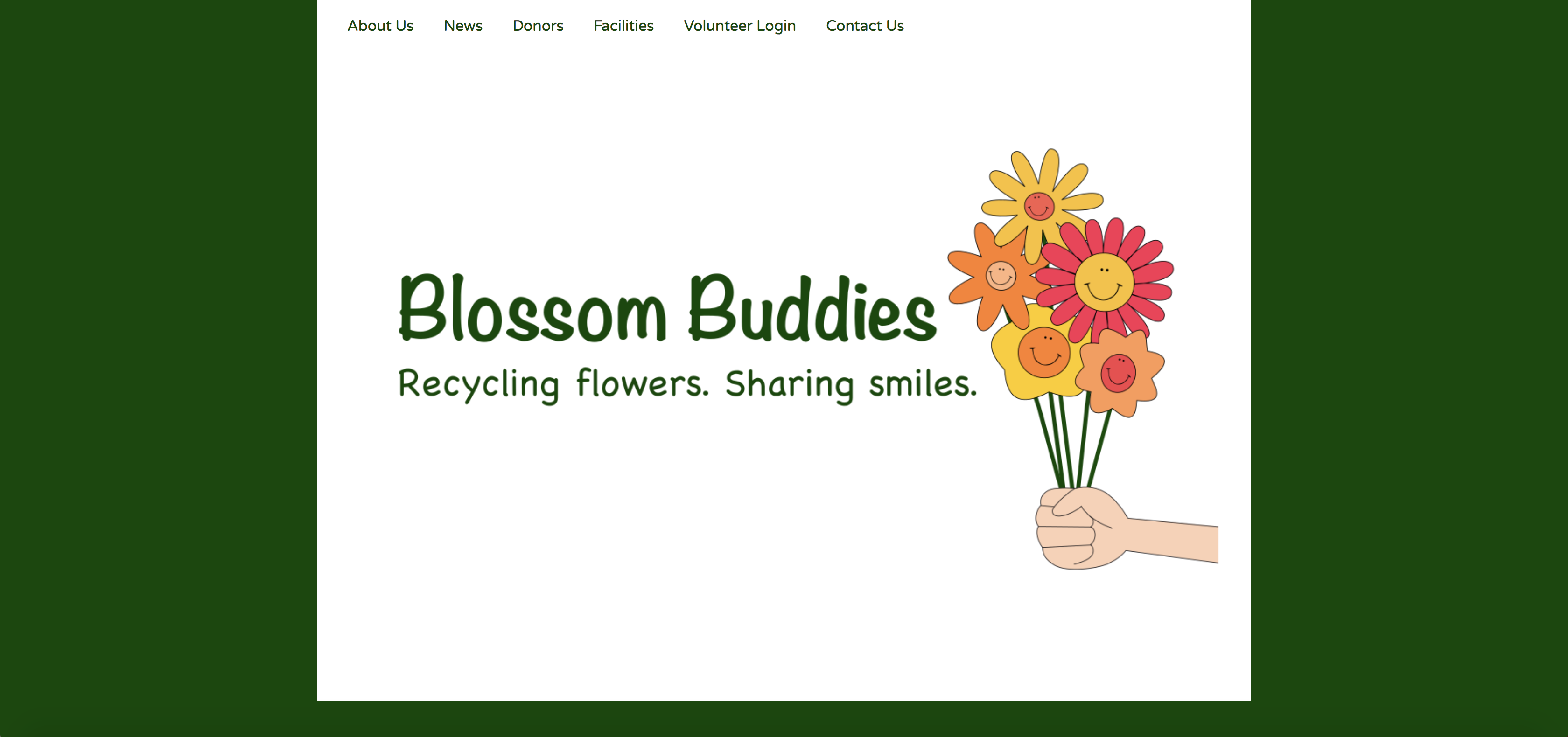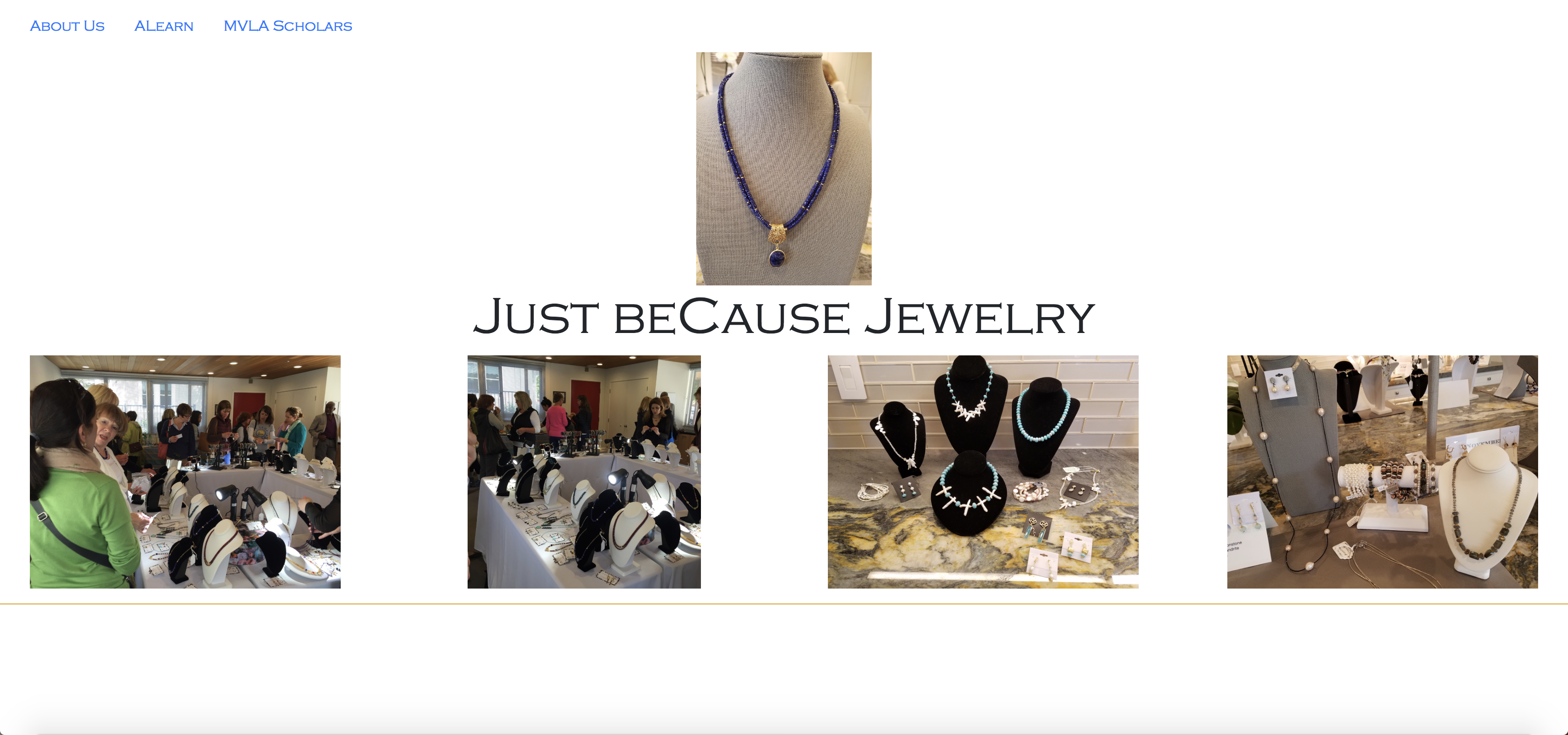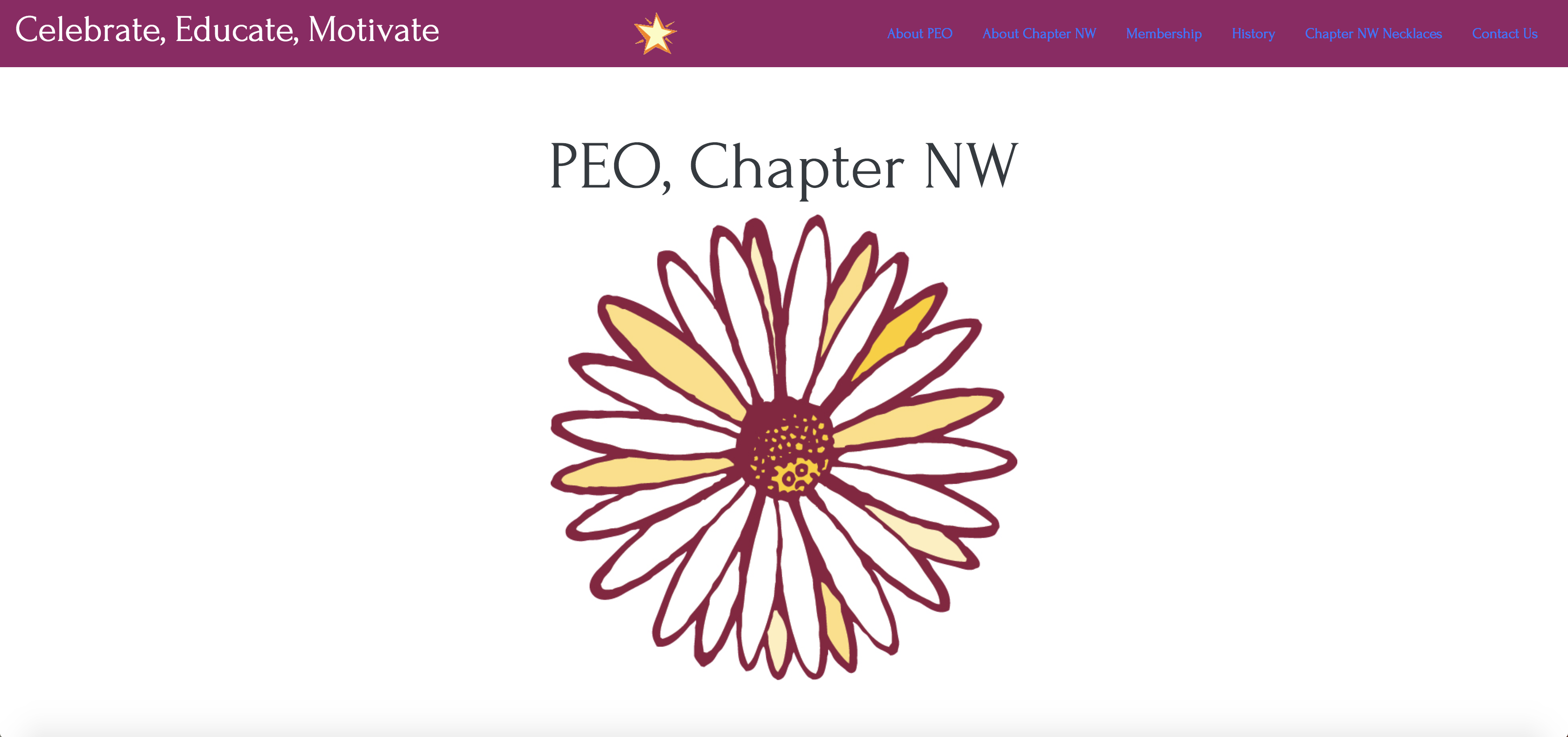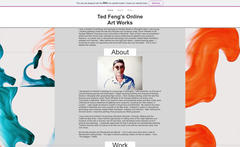Freelance Web Developer
Projects

Blossom Buddies, a non-profit organization that collects leftover flowers from grocery stores and delivers bouquets to patients in hospitals and nursing homes

Just beCause Jewelry, a non-profit organization that designs, creates, and sells jewelry and donates the proceeds to local non-profits focused on educational opportunity

PEO, Chapter NW, a non-profit organization that raises money for women’s scholarships

Ted Feng’s Online Art Works, a website that helps a local artist share his artworks with others
Comments
I’m very impressed! I’m so happy you are putting your skills to good use. It seems like your work is very appreciated by the communities that you have helped. It’s great hearing about everything you’ve been up to. Keep up the great work!
Thanks for doing all this. Everyone in the group has been very complimentary of the website. It will serve our purposes well.
We love it. I’ve gotten so many compliments on the website. It is great way for us to spread our message, thank you so much for taking this on and doing such a thorough job.
I like the website. It is simple and looks good. The back drops are creatively fitting. You have been doing a great job. Thank you so much for your help.
This is a fantastic project, and thank you Angeline for taking it on! I don’t think I can say thank you enough for all you have done!!!
Thank you so much for doing all the work you have done so far. You are a lovely person to have wanted to spend your summer utilizing your skills to help non-profits. Bless you for that.
Story
Offering my free services as a freelance web developer, I built websites for multiple non-profit organizations that did not have the technical skills needed to build their online presence. Specifically, I am most proud of coding the website for Blossom Buddies, a non-profit organization collecting leftover flowers from grocery stores and delivering bouquets to patients in hospitals and nursing homes. In the process of implementing my ideas and building modern responsive websites, I improved my technical skills and gained customer service experience.
After discussing with my clients, I planned the specifications for the project. Provided with text and images that my clients wanted to display on the website, I designed the layout using HTML semantic elements and Bootstrap components, such as jumbotrons that call attention to important content and cards that organize related content. Then, I changed the format using CSS Grid and Flexbox and customized the design using fonts and colors that represent the brand. I also created special effects using JavaScript. Brainstorming my own ideas to improve the design, I decided to use a slideshow to represent Blossom Buddies’ mission of recycling flowers and sharing smiles. Experimenting with Bootstrap, a front-end web framework, I created a slideshow that cycles through images showing the process of volunteers picking up flowers from donors, arranging bouquets of flowers, placing finished bouquets in crates ready to be transported, and bringing cheer to patients in health care facilities. Expecting that the website would be viewed on different devices, I validated the website on multiple browsers and screen sizes. Furthermore, I shared my progress with my clients, and I made changes to the user interface based on my clients’ feedback. Finally, I learned the steps of website deployment when assigning a custom domain name to the website and publishing the completed website to the Internet.
Providing non-profit organizations with platforms that facilitate their online goals, I helped them raise awareness about their causes, such as boosting ailing and elderly patients’ mental health. Applying my coding skills to real life, I want to design and develop new technologies to improve people’s practical lives.
Coding Trek
Impact
- 5+ Programming Languages
- 10+ Workshops
- 70+ Students
- 30+ Adults
- 20+ Teens
- 20+ Kids
Websites
Comments
I am so impressed! I think it is amazing that you are sharing your knowledge with others and making a positive impact on the community. Helping others is one of the most important things anyone can do. Keep up your great work both as an enthusiastic learner and as a teacher!
Thank you again for doing the coding classes - you de-mystified current coding trends and showed us how to continue to learn on our own!
Thanks for a very enlightening class. Very impressive for a high school senior. You’ll go places and I’m sure we’ll be reading about you!
Thank you for your patient instruction. It is very kind of you to share your time and talents with others. I wish you much success in your future endeavors. I have every confidence that you will accomplish much in your lifetime. Your mother is and should be very proud of you.
I want to thank you very much for your class this morning. You are so patient and non-judgmental. You are so kind to give up your Sunday morning to share your knowledge with us. I admire your ambition, initiative, and confidence.
I really learned a lot from your first session! You’re a good teacher!
Thank you for leading the workshop yesterday. Although we barely scrapped the surface of coding, I learned a great deal. I appreciate your taking the time and effort to teach us.
Thank you very much for teaching HTML and CSS to my daughter. She really enjoyed it and very happy that she learned HTML and CSS today. I really appreciate your help and support to the community.
Story
Passionate about both learning and teaching coding, I provided free computer science education to adults, teens, and kids who have not had the opportunity to be updated on new technology. My experiences with learning programming specifically come to mind when I think about the importance of making computer science accessible to beginners. Three years ago, as a novice programmer, I spent most of my time debugging syntax errors, and I was frustrated with my limited programming abilities. Gradually, as I acquired more skills, I quit using prewritten code and began writing my own. Programming then became a process of breaking up the intended outcome into component modules. Wanting to share my experience and help others to overcome similar challenges, I designed a computer science curriculum for beginners, founded Coding Trek, and worked with the Town of Los Altos Hills to organize a series of free coding workshops for all ages.
In this capacity, I introduced web development and computer science to a classroom filled with students. At first, students thought computer science to be theoretical and abstract. During class, I explained how computer science can be applied to real life, and I encouraged students to code programs connected to their interests. For example, a final project was coding a Battleship game using conditionals, loops, and lists, which showed students a real world application of computer science. Leading students with no prior coding experience, I thoroughly explained each line of my code using non-technical language. Making sure that all students had a working final project, I methodically debugged their programs. In a few hours, I turned beginner programmers into competent programmers and made computer science less intimidating for beginners. Many students began to realize that computer science is both applicable and enjoyable, and most wanted to learn more. Multiple students thanked me for my “calm, generous, competent” instruction. Specifically, I recall teaching a lady who had no prior coding experience how to build a website to promote her online business. She thanked me for being patient and nonjudgmental when updating her on new technology.
My efforts to promote computer science education have significantly impacted the community. Guiding students through the process of learning computer science, I encouraged them to explore their interests and helped them acquire the skills needed to implement their ideas. As a mentor, I have positively influenced my students and favorably changed their perspectives about computer science.
Silicon Valley Star Trek Club
Websites
Comments
Good for her, find something positive you like and build on it. Don’t get discouraged by people who “don’t get it” if everyone let that happen there would be no Silicon Valley.
Ms. Chen -- Thank you very much for founding a Star Trek group, and for having the wisdom to know that in-person interactions are what is really important. That is so refreshing and unusual in someone so young. Too many young people these days seem to rely almost entirely on their smartphones for interactions with others.
Story
April 26, 2017, is a day I will never forget. My club membership doubled after The Mercury News published an article about my story. Enjoying the results of my efforts, I grinned.
From a young age, I have been an enthusiastic Trekkie. Over the years, my interest in Star Trek has changed from collecting action figures and starships to ruminating over themes concerning social equality and technological innovation. In multiple ways, Star Trek characters have inspired me.
Seven of Nine has taught me to explore my individuality. As a timid little girl, I feared the unknown and rarely expressed opinions. My parents, therefore, organized activities for me, such as swimming, badminton, table tennis, fencing, rock climbing, and piano recitals. These activities were wonderful explorations from which my individuality grew; however, since high school, I have desired to pursue interests on my own.
Kathryn Janeway has taught me to overcome challenges with determination. To share my interest in Star Trek, I planned to form a starship crew at school. Perplexed by my enjoyment of an “old-fashioned” series, my friends showed no interest whatsoever. Instead of becoming discouraged, I decided to provide a thought-provoking discussion venue in the local community and to promote Star Trek’s principles of diversity, equality, and justice. Although my idea did not take off at school, not giving up led to something else.
Data has taught me to put great effort into accomplishing seemingly impossible goals. Reaching out to strangers takes more planning and courage than simply inviting classmates. I, an inexperienced teenager, was daunted at the thought of making connections with individuals who seemed inaccessible outside of school. Nevertheless, approaching the general public has challenged me to become assertive.
Spock has taught me to control my emotions, especially when failure looms. Starting my club, I was optimistic about my idea. I set my hopes on posting flyers at libraries and community centers, expecting that my club would become an immediate success. Several months later, I was disappointed that only three people had registered; failure crossed my mind. Instead of giving into frustration, I focused on compiling quotes I had gleaned from episodes into souvenir booklets for members to contemplate.
Jean-Luc Picard has taught me to patiently deal with uncertainty. I initiated online discussions about the ethics of artificial intelligence, the role of technology in society, and the possibility of a utopian future. However, no one responded. Anxiously looking forward to the first club meeting, I worried that no one would attend. When two adults unexpectedly showed up, I was thrilled. Their participation and encouragement motivated me to continue to patiently reach out to more people.
James Kirk has taught me to boldly explore new experiences. After having spent months pondering how to raise awareness about my club, I decided to discover the unknown, where no teenager had ventured before. Stating my desire to expand my club across Silicon Valley, I contacted three local newspapers. To my surprise, all reporters expressed interest in interviewing me. Soon, I was featured in “Teen Hopes Star Trek Club Lives Long and Prospers,” “Palo Alto Teen Creates Her Own Trekkie Starship Crew,” and “Star Trek Travels Well Even to the Next Generation.” Subsequently, membership grew from three to thirty-three and included Ph.D.’s, teachers, retirees, and authors!
Multiple members delighted in reading my quote booklets and discussing the related issues. A blind IBM retiree thanked me for helping her to connect with other fans. A reader of Palo Alto Online praised me for persevering passionately like a Silicon Valley entrepreneur. Another reader admired me for valuing face-to-face club meetings over social media. In founding my club and contributing to the community, I have learned to push my boundaries, and I have grown from a passive follower into an active leader. Star Trek’s life lessons concerning exploration, resoluteness, and integrity will always inspire me to pursue my insatiable curiosity and to explore the unknown.
Hobbies
- Jigsaw Puzzles
- Swimming 🏊
- Badminton 🏸
- Table Tennis 🏓
- Fencing 🤺
- Rock Climbing 🧗
- Piano 🎹
Travel
San Francisco
My enthusiasm for learning surprises me at moments. Riding a cable car as a tourist in San Francisco, I simultaneously traveled in my imagination. Physics, artificial intelligence, and wealth inequity topics hovered in my mind while I observed the passing scenery.
Visiting various landmarks that represent aspects of San Francisco history and culture, I pondered over current problems that demand solutions. The separation between Chinatown, an enclave that represents the Chinese immigrant culture, and the other divergent European-American cultures reminded me of the continuing struggle in America over ethnic and gender diversity and rights. Diversity must be accepted and appreciated for society to authentically progress. People generally treat differences better than they did in the past, yet extreme polarization on a variety of issues challenges us to find common ground in order to develop an equitable, sustainable future. Passing Fisherman’s Wharf, a tourist destination known for its famous restaurants, I noticed that some tourists were throwing away bread bowls after consuming only the soup; in the meantime, the homeless were scavenging for food in trash cans. Abruptly, my mind moved on to wealth inequity and waste accumulation. Ironically, consumer culture wastes so much while many people live on streets with insufficient food. Extreme wealth inequity compromises the quality of many people’s lives. Riding the cable car, I observed the juxtaposition of modern and dilapidated neighborhoods. That financial institutions hoard wealth was readily apparent in the scenery. This begs the questions: “How can income inequity and social injustice be ameliorated so that compassion becomes the universal norm?” and “Would people be motivated to improve humanity if the need to make money ceased to exist?”
Lurching forward and backward as the cable car moved, I moved on in my imagination to inventing a system with inertia-countering effects on spacecraft that would keep astronauts comfortable during the tremendous acceleration and deceleration necessary for entering and leaving solar systems. This technology would increase the possibility of finding new life forms across the galaxy, which leads me to ask, “Since humans do not treat each other equally and with dignity, will they treat new life forms abusively, too?” and “Having overcome poverty, disease, and war, will humans in the future work together to explore the universe?”
Applying the technology in cable cars to modern transportation, I imagined inventing transportation that uses cables instead of engines to move to and from specific places. This technology will provide safety and accurate predictability but would be difficult to implement unless the cables were energy beams and not physical objects. This technology begs the questions: “Would using a system of cables be easier to implement than inventing self-driving cars?” and “Would a new system of transportation be inaccessible to most people because of wealth inequity?”
Riding the cable car, I met diverse passengers, including not only thrilled tourists who whooped at drops and encouraged the cable car driver to speed up but also indifferent commuters who constantly stayed on their smartphones. These observations reminded me of how easily balance can be lost when one or more activities become obsessive. As someone who is as yet completely unacquainted with social media, I have observed that people seem to be losing their individuality and their humanity by valuing social media over face-to-face interactions. People have become connected to a collective link, the Internet, and they have become more similar to machines than humans. This occurs because nuances layered with face-to-face exchanges are lost with social media communications. Ironically, technology connects people who are far from each other yet separates people who are sitting next to each other.
Balance naturally produces happiness and decreases stress, and I want to find ways to balance technology and humanity so as to make life more efficient and meaningful. While the Internet can assist me to acquire knowledge, the Internet does not encourage the virtuous growth of kindness, a key ingredient of our humanity. When I want to find information about an interesting topic, I can conveniently and efficiently find many sources on the Internet; however, the Internet has significantly eliminated the need for human interactions. Principal among these is the fact that my family only forms stronger relationships primarily when we do activities together.
As my cable car ride continued, I observed the driver’s repeated movements and imagined inventing bionic brains that create neural pathways to simulate human learning. Three questions concerning this technology arise. “Should intelligent machines be treated like new life forms?” “Would cable cars operated by intelligent machines feel less welcoming than cable cars operated by humans?” “Would such a reliance on technology cause people to lose their humanity?” Furthermore, this technology would allow intelligent machines to replace cable car drivers. If this technology were generalized, it would have significant consequences. I considered the likelihood that intelligent machines would gradually replace human jobs and quite possibly careers, which would leave many people with no income.
Technology has become ubiquitous. Will people learn to balance technology and humanity so as to make life more well-rounded? Will technology take over people’s lives, causing a loss of individuality and humanity, thus possibly reducing people to automatons? As technology improves, the issue of balance will surface again and again. In the future, machines with artificial intelligence that think like humans will blur the boundaries further between human beings and machines.
My experience riding the cable car illustrates that significance primarily relates to my eagerness for learning in whatever environment I happen to find myself. I delve into the unknown with a desire for exploration. My insatiable curiosity has me determined to assess ideas and their feasibility. Generating multiple perspectives, my imagination cavorts in unrestrained play.
Disneyland
As a child, I used to visit Disneyland with my family every summer. When my parents led me to the entrance of the ride, I would observe riders from the sidelines. If I heard piercing screams, I would walk away immediately. As a result, my fear of riding frightening roller coasters limited my enjoyment of the world-famous rides in Disneyland. Gradually, bored with riding slow rides for kids, I outgrew Disneyland, removing it from my summer vacation plans. Five years later, I decided to visit Disneyland again as a teenager ready to challenge my childhood fears.
Splash Mountain, a log flume with a five-story drop, was the first ride that I wanted to try. Having been afraid of junior roller coasters with miniature drops, I hesitated to experience a massive drop. Retrospectively, I had dreaded giving control to the mechanisms and waiting for the brakes to decide the timing of the drop. Furthermore, the feeling of weightlessness had always been accompanied by motion sickness. My organs had seemed to be dislocated, my pounding heart had seemed to rise, and my turning stomach had seemed to sink. For many years, this brief floating sensation had discouraged me from exploring thrilling rides.
Standing next to the entrance of Splash Mountain, I observed logs arriving through a gaping hole in a twisted tree trunk, plunging over a waterfall, and spraying water droplets on a dense thicket of thorny plants. Wanting to test my readiness for scarier roller coasters, I mustered the courage to get in line. I constantly reassured myself that rides are not life-threatening; they are only designed to thrill riders. In a worst-case scenario, I would be nauseous but alive. Waiting for my turn, I observed that other riders exiting the ride were grinning, so I suspected that they had been screaming with excitement instead of fear. This revelation comforted me when I boarded the ride.
Sitting in the log, I drifted with the peaceful current, entertained by singing rabbits, geese, possums, and alligators dressed in hats, scarves, and shirts. The story of a rabbit’s adventure unraveled as the log travelled from the Briar Patch, the critters’ home where the warm yellow lighting cordially welcomed visitors, to the Laughing Place, a colorful cave where the strange blue lighting ominously warned visitors of imminent danger. Finally, hearing gears cranking and seeing light at the end of the tunnel as the log ascended with the conveyor lift belt, I suspected that the unavoidable drop was ahead. Perching on a dimly lit branch, vultures taunted visitors about using the drop to escape the frightening scene of a kidnapped rabbit tied up by a voracious fox. Observing that the log would immediately fall, I braced myself for the drop, gripping the handles and closing my eyes. Surprisingly, the drop passed so quickly that I did not have time to enjoy the adrenaline rush. Realizing that the ride was not so frightening as I had expected, I wanted to immediately get in line again.
Boarding the ride again, I requested a seat in the front row, where I would have an unobstructed view of the track ahead. When the log reached the top of the drop, abruptly transitioning from the dark lair to the bright aperture, I kept my eyes open. Appreciating the aerial panoramic view of Disneyland, I glimpsed the bustling crowds hurrying to their next attraction, riverboats and canoes gliding on the Rivers of America, and the iconic replica of the Matterhorn looming above Fantasyland. Then, the log tipped, rushing toward the bottom of the drop and creating a wave that towered over the log and crashed on my seat. Having fully appreciated my experience, I soon desired to try new rides.
Passing through the central hub connecting the eight distinctively themed sections of Disneyland, I crossed the border between a quaint town on Main Street and a space station in Tomorrowland. My destination was Space Mountain, an indoor roller coaster. Unlike Splash Mountain, a tranquil ride with few drops, Space Mountain was a turbulent roller coaster with multiple unexpected drops in the dark. Moreover, my dad said that Space Mountain was the scariest ride that he had ridden in Disneyland, which increased my nervousness and my hesitation.
Pacing next to the entrance of Space Mountain, I had no expectations about the unknown indoor ride. The only hint given about my impending experience was the warning of fast speeds, sudden drops, and sharp turns. Entering the indoor queue area, I was immediately immersed in the futuristic space theme. I believed that I was actually on a space station where rockets were being loaded and unloaded, which reminded me of Disneyland’s unique ability to transport visitors to diverse fantastic locations, ranging from a rustic land housing anthropomorphic critters to a high-tech land predicting the future of innovation and exploration.
Preparing for takeoff at the launch pad, I gripped the lap bar, trying to alleviate my apprehension. Soon, I was launched into space, listening to blaring galactic music. I passed through a tunnel with flashing lights, swirling walls, and pulsating energy beams as power was being transferred to the rocket. Approaching the galaxy at the top of the hill, I whooshed past stars that left streaks in the dark sky and glowing orbs that resembled monochromatic disco balls. Wind blew against my face, making my eyes watery and my mouth dry. Experiencing moments of free fall, I felt as if my body were leaving my seat. As the ride continued, the drops seemed to become larger, and the turns seemed to become sharper. I was jerked with the turbulent movements of the uncontrollable rocket. Finally, returning to the launch pad, I convinced myself that I was ready to ride more thrilling roller coasters.
Racing to my next destination and navigating through the crowds, I arrived at California Screamin’, a steel roller coaster with a 120-foot drop and a 1 1/8-mile track. Soaring above the boardwalk, California Screamin’ was known as the most thrilling roller coaster in Disneyland. Unlike Space Mountain, which only had drops and turns, California Screamin’ had a vertical loop. I had qualms about riding a roller coaster with a 360-degree turn, expecting that my wobbly legs would inhibit my ability to stand up afterwards. Ready to overcome my last fear of roller coasters, I was motivated to get in line, meandering through the maze of poles that led me to the boarding area.
Fastened to the vehicle by a rigid shoulder restraint, I reached the launch zone, where an announcer reminded everyone that it was too late to turn back. I anxiously waited for the countdown to end and the ride to start. As the vehicle accelerated at a dizzying speed, I simultaneously started to analyze the physics of the ride. Hearing whirring motors, I observed that electromagnetism was propelling the vehicle forward to the first scream tube. Lurching forward, backward, and sideways, I observed that inertia was forcing my head against the headrest. Gradually, I lost count of the number of hills until I saw the 360-degree vertical loop ahead of me. Suddenly, external forces tucked my head closer to my body, preventing me from looking upside down at the ground. The rush of blood to my head was instantaneous and imperceptible. The vehicle continued to ascend and descend the hills, whizzing past the roofs of buildings on the boardwalk. As the drops became smaller and the turns became smoother, I observed that energy conversion was causing the vehicle to lose energy and slow down. Finally, returning to the boarding area, I regretted not having enough time to experience the physics of roller coasters and relate sensations to specific physics concepts.
Applying the thrills of riding roller coasters to my daily life, I desired to explore new experiences and discover new ways of thinking. My experience riding roller coasters in Disneyland has helped me learn to take risks and overcome challenges when I founded two clubs in the local community, Silicon Valley Star Trek Club and Coding Trek, which required courage and perseverance. Proposing my ideas to the general public and overcoming my childhood shyness, I was reminded of my experience riding Splash Mountain, which taught me to leave my comfort zone and push my boundaries. Discouraged by people who do not support my efforts, I was reminded of my experience riding Space Mountain, which taught me to form my own opinions instead of following others’ opinions. Hesitantly facing the possibility of failure, I was reminded of my experience riding California Screamin’, which taught me to take advantage of the opportunity to try new activities so that I would not continue to wonder about the experiences that I have been missing. Although Disneyland is often considered as an imaginary place that is far from reality, my experience visiting the theme park has significantly influenced my personal growth from a timid child to a confident teenager.


